Criticism
Television's Giant Step
Written And Illustrated By Mare Ganea Fitzgerald
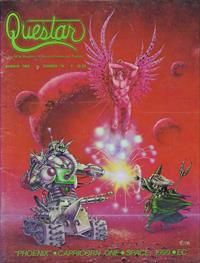
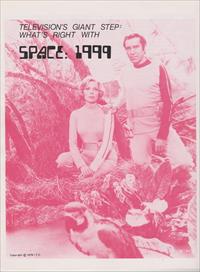
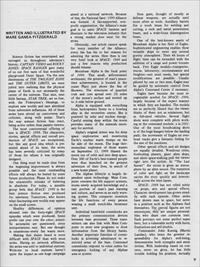
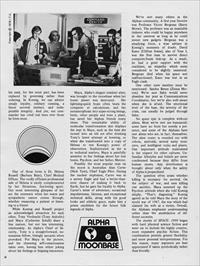
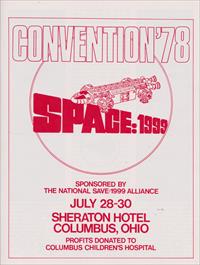
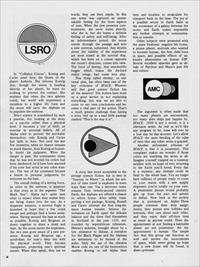
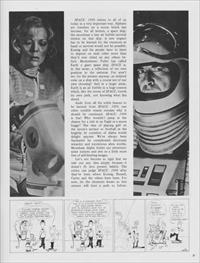
Mare Fitzgerald was a president of the National Save: 1999 Alliance (later the International Space 1999 Alliance), and ran the Prentis Hancock fan club. Her explanations of the Alphan badges (which illustrated this article) are widely accepted by fans. Similarly this 1978 article, for American fan magazine Questar, was an influential explanation of the appeal of the series.
Science fiction has entertained and outraged us throughout television's history. Captain Video and Rocky Jones: Space Ranger gave many of us our first taste of that wonderful playground: Outer Space. Via the new dimensions of The Twilight Zone and The Outer Limits, we were jolted into realizing that the physical plane of Earth is not necessarily the centre of the universe. That nice, neat little fantasy, Star Trek, set us free, with the Federation's blessings, to explore new worlds and save alien-kind from subversive influences. All of these series have stirred up controversy and criticism, along with praise. That's the way science fiction fans react, being active rather than passive viewers.
The most controversial offering of late is Space: 1999. The characters, stories, special effects and overall production of Space are exceptional, but like any good idea which is presented ahead of its time, the series has been severely criticized by many of those for whom it was originally designed.
One thing must be made clear from the beginning: improvement is always possible and the most outstanding efforts will always be bested by some future production. Please do not make the unscientific mistake of believing in absolutes. For today, a sizeable group feels that Space: 1999 is the best science fiction ever produced for television. Tomorrow, who knows what fascinating new worlds may appear on the small screen.
Healthy differences of opinion abound over the forty-eight Space which were produced. Some prefer one year over the other; scientific accuracies are questioned; story interpretations vary. But one thought is unanimous---every fan wants more.
Making that desire heard is more difficult with Space than with most series. Having no network affiliation, the series was sold to individual stations. Write-ins to local stations haven't quite the impact as one huge campaign aimed at a national network. Because of this, the National Save: 1999 Alliance was formed. A fan-supported, non-profit organization, the Alliance's main goal is to unite Space fandom and illustrate to the television industry that a strong market does exist for the series.
Obviously, one article cannot speak for every member of the Alliance; every fan has his or her reasons for admiring the series. Here then is one very brief look at Space: 1999 and just a few reasons why production should resume.
Moonbase Alpha is the focal point of 1999. This small, self-contained settlement, the greatest of man's peacetime achievements, is located in the crater Plato just above the Sea of Showers. The structures of quarried rock and ores spread over 21½ miles of the moon's surface and extend up to .6 mile below ground.
This information is based on David Hirsch's Technical Notebook, and is not directly supported by the series (which suggests the area of Copernicus).
Alpha is equipped with everything from hydroponics farms to a bowling alley in the recreation centre. She is powered by solar and nuclear energy. Careful mining deep within the moon provides many of the minerals necessary for survival.
Alpha's original intent was for deep space exploration and monitoring Earth's nuclear waste dumps on the far side of the moon. The huge thermonuclear explosion of those wastes on September 13, 1999 blasted the moon out of orbit and into deep space. Over 300 of Earth's best-trained people were thus launched on the greatest adventure of their lives, in search of a new home planet.
The Alphan lifestyle is largely dependent upon technology. Main Computer oversees the life support systems, stores newly acquired knowledge and a vast portion of man's past learning and culture, and serves as an early warning system. This computer monitors the life functions of every person wearing a small watch-like biosensor unit.
Individual hand-held commlocks are the primary communication devices between base personnel. These transmitters can also link with Main Computer to store new programs or draw information from the library banks. Another important function of commlocks is screening admittance to restricted areas of the base. Command commlocks respond to voice orders for emergency locking of any Alphan area or system.
Stun guns, thought of mostly as defence weapons, are actually used more often as tools. Auxiliary barrels fire a torch beam for welding and cutting, a rock and metal penetration beam, and a wide-focus disintegration beam.
One of the best-known assets of Moonbase Alpha is her fleet of Eagles. Sophisticated engineering enables these versatile ships to enter any normal gravity atmosphere. Their 48 hours of flight time can be extended with the addition of a range and power booster back. Five Eagle models---transporter, rescue, lab oratory, reconnaissance and freighter---suit most needs, but special modifications are possible. Usually piloted by one or two men, Eagles may be guided by automatic control from Alpha's Command Center if necessary.
Eagles have become the most recognizable symbol for Space: 1999, largely because of the expert manner in which they are handled. The models are so perfectly filmed that the viewer thinks of them not as miniatures, but as full-sized vehicles. Several flight shots were complete with pilots working in the command module, a la 2001. One of the most breathtaking shots is of the huge hangers below the landing pads; the movement of Eagles on overhead tracks give a fantastic feeling for the size of the machines.
Other special effects and set designs are equally detailed. Wondrous cities, foreboding planets, giant alien ships, and silent space-walking pull the viewer right into the action. In "The Last Sunset" the moon is given an atmosphere by an alien source. The transition of colour and light on the landscape carries the story quickly and interestingly across the time lapses.
Space: 1999 has not relied solely on props, sets and special effects. Character development has grown steadily with each episode. Other series have shown man in space, but never in a position such as the Alphans find themselves. The central figures are not stereotypes; they are unique personalities who share one common trait. Each portrays not some perfect super hero, but a vulnerable entity with hurts, frustrations and self-doubts.
Commander John Koenig (Martin Landau), who bears the greatest responsibility for Alpha's well-being, demonstrates both strengths and sensitivities. With leadership based on concern, never on glory, he has little trouble holding his position. Actually his rank, for the most part, has been replaced by governing rather than ordering. In Koenig, we can admire steady loyalty, military cunning, a fierce survival instinct, and indisputable integrity. And yes, our commander has cried real tears over those he loves most.
One of those loves is Dr. Helena Russell (Barbara Bain), Chief Medical Officer. The coolly efficient professional side of Helena is nicely complemented by her flirtatious, fun-loving spirit. Our most interesting glimpses of her are the moments when her warm and sympathetic nature comes through, whether reassuring a patient or listening to a friend.
While Koenig and Russell project an acknowledged attraction for each other, Tony Verdeschi (Tony Anholt) and Maya (Catherine Schell) share a less mature, but not less interesting, relationship. As Alpha's Chief of Security, Tony is a straightforward, no-nonsense fellow, bitingly sarcastic when provoked. Put Maya in the picture, and his charming self-consciousness takes over, leaving him either joking about his feelings or feigning innocence.
Maya, Alpha's elegant resident alien, was brought to the moonbase when her home planet was destroyed. Her lightning-quick brain often beats the computer at calculations, and her metamorphosis into super-strong beings, birds, other people and even a plant, has saved her Alphan friends many times. This remarkable ability of molecular transformation also displays the imp in Maya, such as the time she turned into an old sot after drinking Tony's latest attempt at brewing, or when she transformed into a copy of Helena to test Koenig's power of observation. Sophisticated as she is in technical matters, Maya is painfully sensitive to her feelings about her lost home, Psychon, and her father, Mentor.
Possibly the most popular man on the moon is Australian Alan Carter (Nick Tate), Chief Eagle Pilot. During the nuclear explosion, Carter was in a survey Eagle and had a better-than-even chance of making it back to Earth, but he gave his loyalty to Alpha. Carter's sense of adventure, occasional impulsiveness, fairness, and exceptional technical skills, along with his good looks and athletic grace, make him a prime candidate for the future folk legends of Alpha.
We've met many others in the Alphan community. A first year favourite was Professor Victor Bergman (Barry Morse). The professor was an insatiable tinkerer who could be happy anywhere in the universe as long as he could invent new gadgets. Bergman was a steadying force, a wise advisor in Koenig's moments of doubt. David Kano (Clifton Jones), also of Year 1, was the first man to survive direct computer/brain link-up. As a result, he had a great rapport with the machines, an empathy which some considered to be slightly unnatural. Bergman died when his space suit malfunctioned; Kano was lost in an Eagle crash.
One other crew member must be mentioned: Sandra Benes (Zienia Merton). We're sure Sahn would never abandon her post as Communications Coordinator, but we're also well aware when she is afraid. The emotional level of the base, the severity of the crisis, can usually be judged through Sahn.
No space epic is complete without aliens. Most we've met are humanoid; some have no form but merely a presence, and some of the Alphans have met aliens who are, in fact, themselves. The alien roster is rounded out with robots, androids, several nasty monsters, and intelligent rocks and plants. One important attitude maintained is the respect for other cultures. Unfamiliar lifestyles and beliefs are never condemned because they differ from human mores. Any interference is brought about only when the safety of Alpha is jeopardised.
The question often arises whether killing is necessary for survival. On the subject of war, and men killing one another, Maya summed up the Psychon attitude when she told Koenig simply, "That's disgusting." Koenig agreed as he told Maya the story of the world war of 1987, the war which had claimed his wife as a victim. Overall, the Alphans emphasize understanding rather than the annihilation of different societies.
The stories of Space: 1999 began with hard physical science fiction and went on to include the highly creative, more expansive psychic fiction. This combination permits greater flexibility and more personal interpretations. For this reason, many segments are best appreciated if taken symbolically rather than literally.
In "Collision Course", Koenig and Carter meet Arra, the Queen of the planet Astheria [Atheria]. She informs Koenig that, though the moon is heading directly at her planet, he must do nothing to prevent the contact. She explains that when the two spheres touch, her world will experience a mutation to a higher life form and the moon will carry the Alphans on to populate the universe.
Strict science is scandalized by such a premise, but looking at the story on a psychic rather than a physical level, it becomes a test of faith; an exercise in personal beliefs. All of Alpha tried to prevent the inevitable destruction; only Koenig and Carter had faith in Arra. Not until the last few moments, when no chance remains to avoid disaster, does Koenig so humanly doubt his judgement. When the danger is past, the commander states that he was not worried his orders had been disobeyed; he'd have been alarmed if his crew had acted in any other manner. The test of his command became a lesson in personal judgements for everyone on the base.
The overall feeling of a driving force, an order in the universe, is apparent in that story as in the segment "The Black Sun". Alpha isn't quite sure what to expect when they realize they are being drawn into the sun. As a desperate measure, a survival Eagle is launched in hope that a few could escape and perhaps and a home somewhere. Having secured the base as much as possible, Koenig and Bergman sit down together to share a drink and wait. As the moon enters the implosion, the two men grow aware of a new presence. Koenig and Bergman age, a symbolism for man's deep ties with the physical world. They become transparent, projecting man's spiritual nature. When they speak, they use no words; they use their minds. In this one scene was captured an unmistakable feeling for the three aspects of man. When the new presence communicates, she never states directly who she is, but she leaves a definite feeling of safety and well-being. After an indeterminate period, the moon travels through the passage and into a new universe, unharmed. Any doubts about the validity of the experience are soon erased as the survival ship, which has been on a course opposite the moon's direction, comes into view. The force of destiny, that unscientific bugger which makes the die-hard realist cringe, had come into play.
This thing called destiny, or universal plan, has often been one of the key criticisms of SPACE. Whoever said that good science fiction has all the answers? The writers have done us a great service in not explaining everything; this way we are able to come to our own conclusions and become a vital part of the action. That's a much greater challenge than having a story tied up in a neat little package marked "This is the way it is".
A story line more acceptable to the average science fiction fan is seen in "Journey to Where" in which the subject of time travel is explored in more ways than one. Via a neutrone [neutrino] transmission from twenty-second century Earth, the Alphans are offered a chance to return home. After safely transporting a test package, Koenig, Russell and Carter attempt the first long-distance human transfer. Seismic disturbances on Earth upset the delicate balance and the three find themselves in Scotland in the year 1339, surrounded by superstitious tribesmen. Helena's sickness, brought about by a low resistance to disease, is mistaken for the Black Plague and the Alphans are sentenced to be burned at the stake. Only the use of the obsolete Morse code on one of the biomonitors enables Koenig to tell Alpha their time and location to recalculate for transport back to the base. The joy at a possible return to Earth fades as the movement of a galaxy between the moon and Earth makes impossible any further attempts at communication or transfer.
Other subjects were presented with the same freshness: negative life forms, a prison planet, androids who wanted to become human, the first child born in space, and possible effects of unknown phenomena on human ESP. Several excellent episodes gave us details of Psychon and Maya's past life and culture.
The argument is often made that too many planets are encountered, too many alien ships just happen by. Space: 1999 is not a movie; it is a television series. As real as we'd like any program to be, none will ever be a true day by day account. Let's allow Space the same bending of the rules of time that any other series is granted.
Another unfounded criticism of Space is that it is pessimistic. This complaint makes me wonder if those critics are watching the series at all. Imagine yourself trapped on a runaway satellite with no hope of ever returning to the Earth you'd loved. Every day is a mystery; any mistake could be fatal to the whole base. You no longer have millions of people ready to come to your rescue with a new supply shipment; you're totally on your own. A pessimistic person would probably give up from the start and submit to defeat. Now look at the society that is portrayed on Alpha: These people continue their duty assignments, they pursue new hobbies and interests, they care about each other, and they enjoy their off-duty time as much as anyone could. Their disappointment at not finding a habitable planet are not pessimistic; the disappointment is human. The simple fact that this group can function so well and survive the uncertainties of space, while never giving up hope that a new home will be found, is sheer optimism.
Space: 1999 relates to all of us today in a very important way. Alphans are travellers on a moon which has become, for all intents a space ship; the moonbase a tiny air bubble survival station on that ship. A new respect has to be learned for the resources at hand or survival would not be possible. Koenig and his people have to learn to depend on each other more than they'd ever relied on any others before. Buckminster Fuller has called Earth a giant space ship. Space is, in this sense, a reflection of our own position in the universe. For aren't we, for the present anyway, an isolated crew on a ship with a course not of our own choosing? And in a larger sense, Earth is an air bubble in a huge cosmos which, like the moon of Space, travels its own path, not knowing what lies ahead.
Aside from all the noble lessons to be learned from Space: 1999, one other notable reason remains why it should be continued. Space: 1999 is fun! Who wouldn't jump at the chance for a ride in an Eagle or a moon buggy? The idea of playing golf on the moon's surface or football in the brightly lit corridors of Alpha would delight anyone. We've always been fascinated by complicated electronic wizardry and mysterious alien worlds. Moonbase Alpha tickles our adventuresome natures and sets us a little more free of self-limiting images.
Let's not become so rigid that we rule out any idea simply because it doesn't fit into present beliefs. The critics can judge Space: 1999 after they've been where Koenig, Russell, Carter and the others have been. For now, let the dreamers dream so that science will have a path to follow.